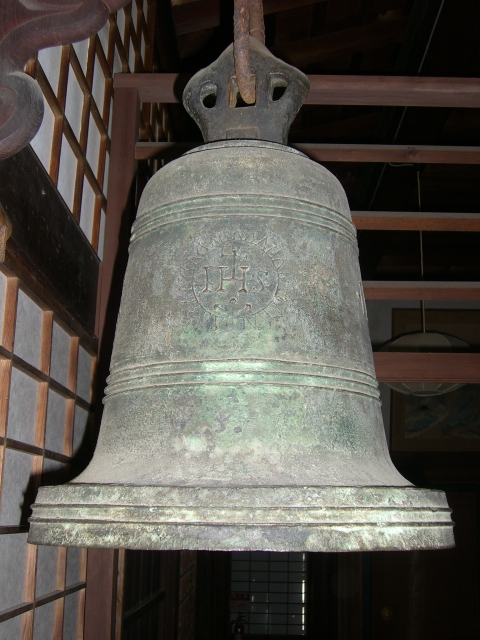Nanban-ji on:
[Wikipedia]
[Google]
[Amazon]
 Nanban-ji (南蛮寺, also pronounced ''Nanbandera'') is a name applied to spaces or structures used by Christian missionaries and Japanese Christian converts in the early
Nanban-ji (南蛮寺, also pronounced ''Nanbandera'') is a name applied to spaces or structures used by Christian missionaries and Japanese Christian converts in the early
history of the Catholic Church in Japan
Christian missionaries arrived with Francis Xavier and the Jesuits in the 1540s and briefly flourished, with over 100,000 converts, including many ''daimyōs'' in Kyushu. It soon met resistance from the highest office holders of Japan. Emperor Ōgi ...
. Whether converted from existing temples or built for purpose as churches and centers for Christian education, buildings known as Nanban-ji (temple of/for the southern barbarians) were present in Kyōto
Kyoto (; Japanese: , ''Kyōto'' ), officially , is the capital city of Kyoto Prefecture in Japan. Located in the Kansai region on the island of Honshu, Kyoto forms a part of the Keihanshin metropolitan area along with Osaka and Kobe. , the ci ...
, Nagasaki
is the capital and the largest city of Nagasaki Prefecture on the island of Kyushu in Japan.
It became the sole port used for trade with the Portuguese and Dutch during the 16th through 19th centuries. The Hidden Christian Sites in the ...
, Hirado
is a city located in Nagasaki Prefecture, Japan. The part historically named Hirado is located on Hirado Island. With recent mergers, the city's boundaries have expanded, and Hirado now occupies parts of the main island of Kyushu. The component ...
, Azuchi
was a town located in Gamō District, Shiga Prefecture, Japan.
As of 2003, the town had an estimated population of 12,217 and a density of 502.76 persons per km². The total area was 24.30 km².
On March 21, 2010, Azuchi was merged into th ...
, Osaka
is a designated city in the Kansai region of Honshu in Japan. It is the capital of and most populous city in Osaka Prefecture, and the third most populous city in Japan, following Special wards of Tokyo and Yokohama. With a population of 2. ...
, Kanazawa
is the capital city of Ishikawa Prefecture, Japan. , the city had an estimated population of 466,029 in 203,271 households, and a population density of 990 persons per km2. The total area of the city was .
Overview Cityscape
File:もてな ...
, Sunpu, and Edo
Edo ( ja, , , "bay-entrance" or "estuary"), also romanized as Jedo, Yedo or Yeddo, is the former name of Tokyo.
Edo, formerly a ''jōkamachi'' (castle town) centered on Edo Castle located in Musashi Province, became the ''de facto'' capital of ...
. Using the term ''Deus'' for God, the temples were also called and .
Structures known as Nanban-ji were destroyed from Toyotomi Hideyoshi's 1588 edict against Christians in Japan, with some fragments of construction remaining and eventually being deposited in museums. There are also depictions in contemporary art, and in the narratives of missionaries such as Luís Fróis
Luís Fróis (1532 – 8 July 1597) was a Portuguese missionary who worked in Asia during the second half of the 16th century. While in Japan in 1582, he witnessed the attack on Honnō-ji, a Buddhist temple that ended in the death of Oda Nobuna ...
.See also
*Christianity in Japan
Christianity in Japan is among the nation's minority religions in terms of individuals who state an explicit affiliation or faith. Between less than 1 percent and 1.5% of the population claims Christianity, Christian belief or affiliation. Altho ...
*Nanban art
refers to Japanese art of the sixteenth and seventeenth centuries influenced by contact with the or 'Southern barbarians', traders and missionaries from Europe and specifically from Portugal. It is a Sino-Japanese word, Chinese '' Nánmán' ...
, Japanese art of the sixteenth and seventeenth centuries influenced by contact with the Nanban
*Nanban trade
or the , was a period in the history of Japan from the arrival of Europeans in 1543 to the first '' Sakoku'' Seclusion Edicts of isolationism in 1614. Nanban (南蛮 Lit. "Southern barbarian") is a Japanese word which had been used to desig ...
, trade between Japan and Western countries from 1543 to 1614
References
{{Reflist History of Christianity in Japan History of Catholicism in Asia Catholic Church in Japan